
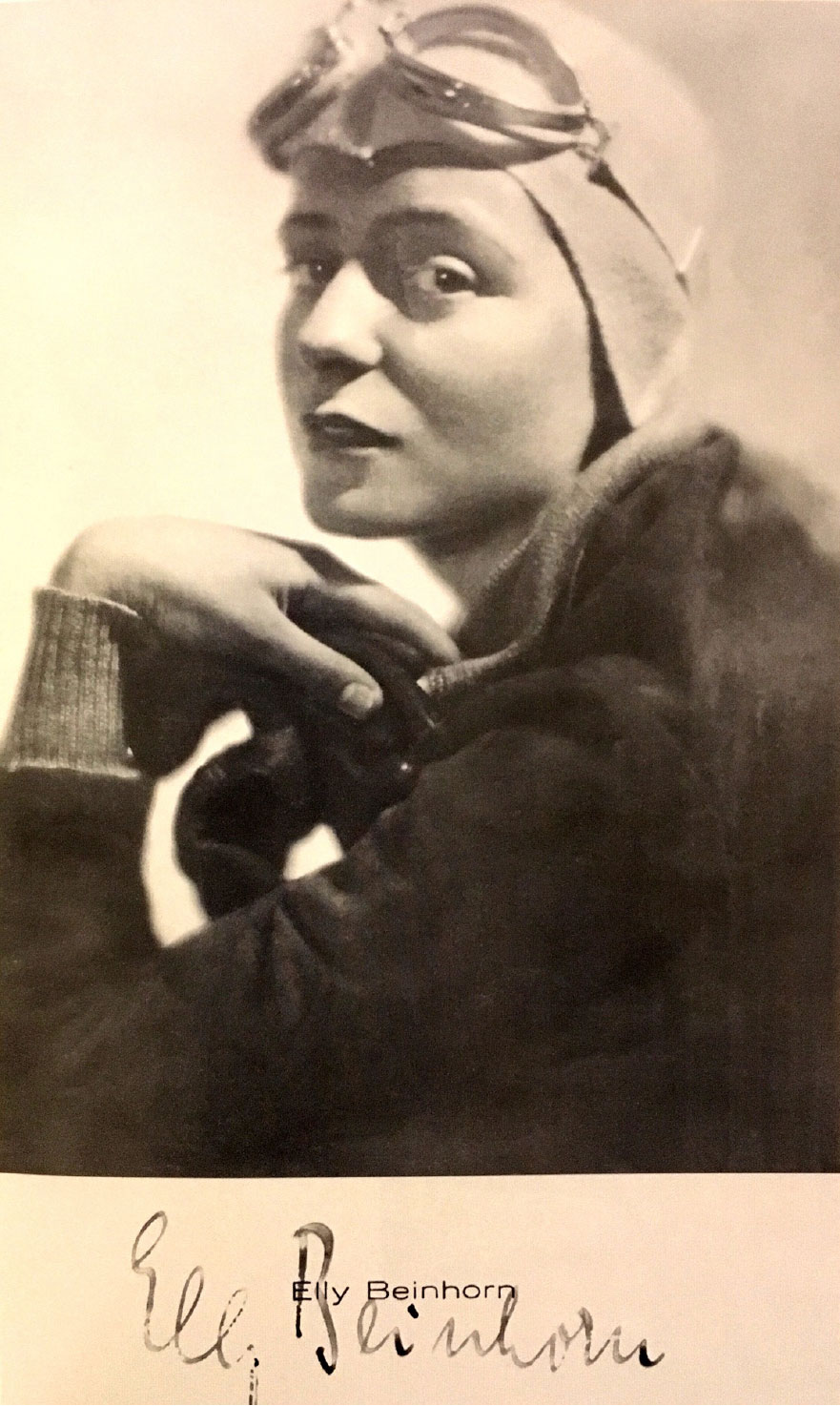
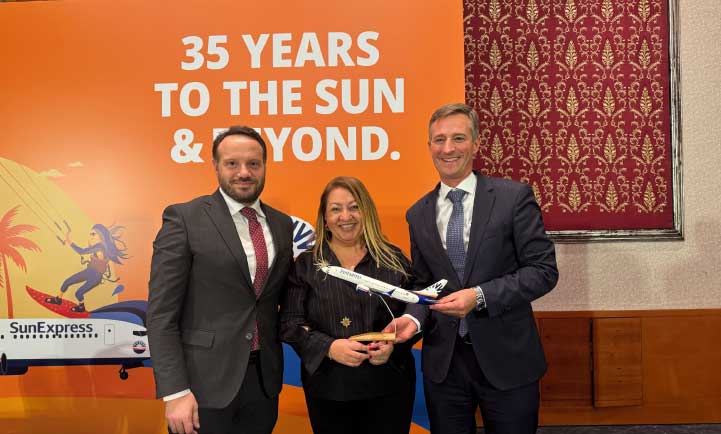
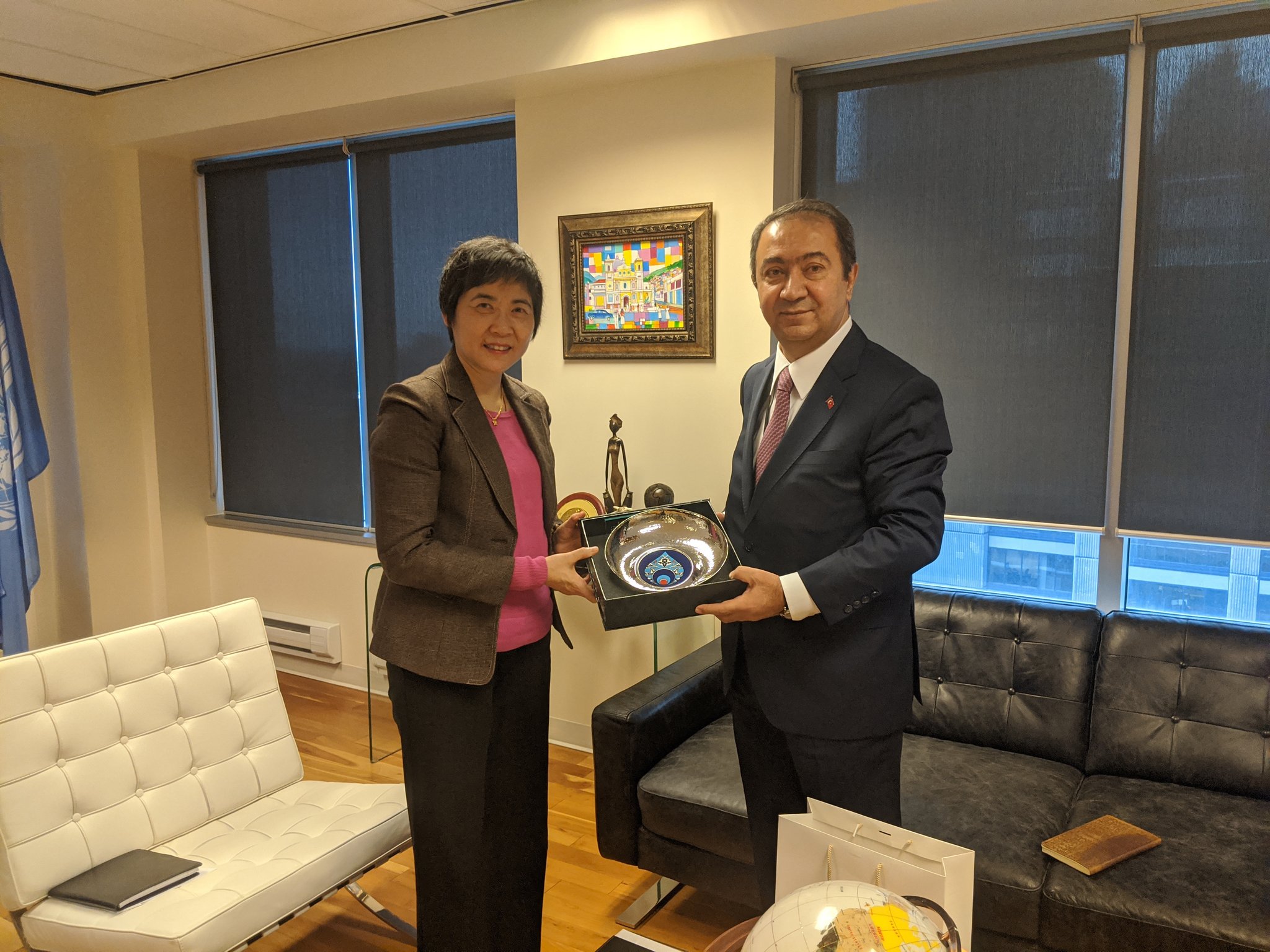

By landing at Istanbul Yeşilköy Airport on July 30, 1931 after covering the distance between New York and Istanbul with a flight lasting nearly 49 hours, U.S. pilots Johnnie Polando and Russel Boardman beat the record of the longest flight in the world and Turkey gained prominent prestige in the realm of international aviation.1 4 years after this achievement, on August 13, 1935, a female pilot from Germany also attempted to make her mark with a similar record. Elly Beinhorn, who completed a world tour by herself in 1932, planned a route from Germany to Istanbul to beat the record of covering two continents and turning back in a day and once again announced her name to the world by covering a distance of 3,570 kilometers within 13.5 hours.2 This achievement had been unheard of in the history of Turkish aviation to date. In this article we will be addressing the subject with the translation of an original brochure written by Beinhorn in person and kept at the institutional archive of the German Aerospace Center (DLR) in Göttingen and with the news appearing on the Turkish press during that time. 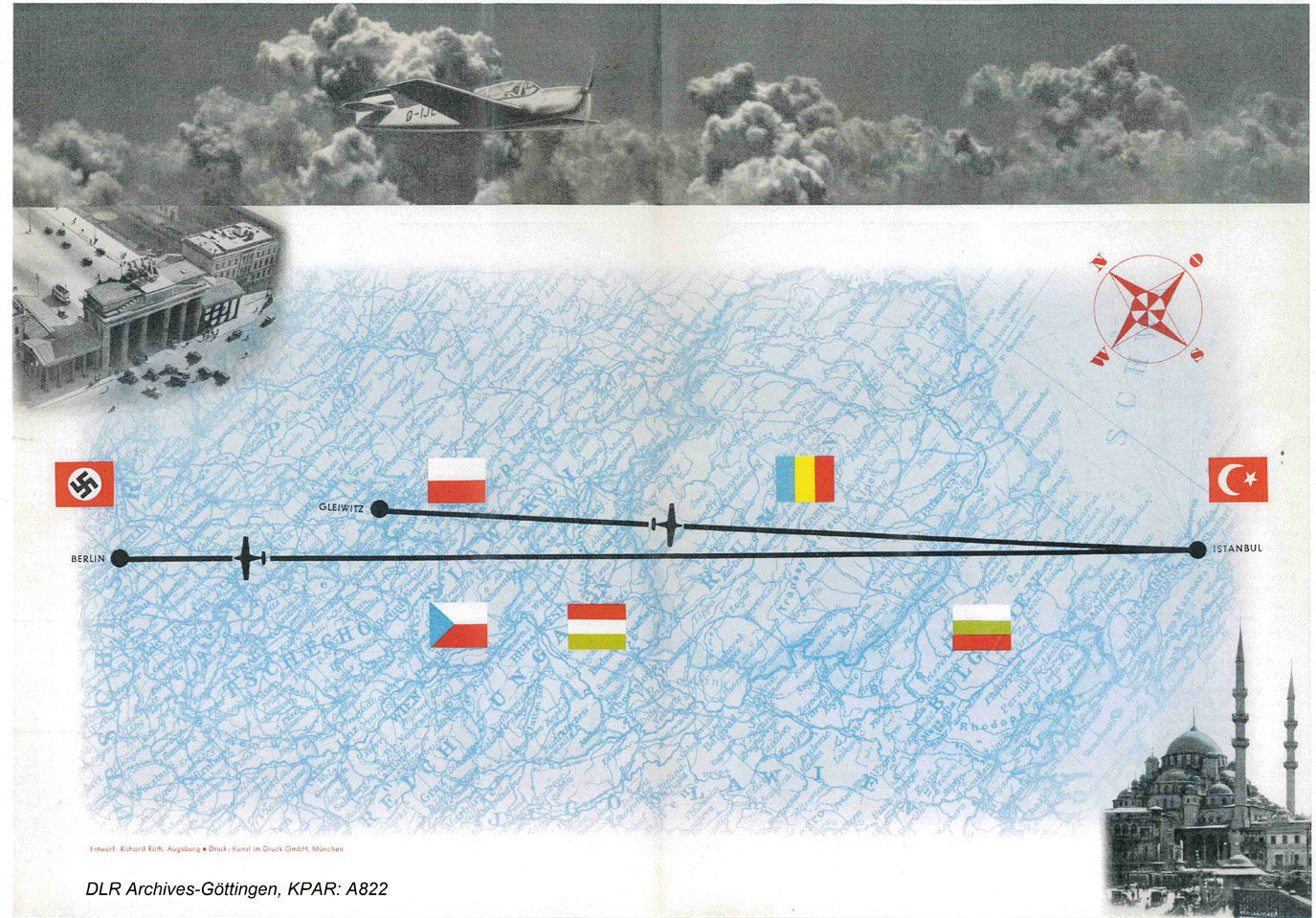 The following is the story of the journey written by Beinhorn on August 17, 1935, after the completion of the successful flight: “Typhoon” over Asia3 When I look back and think, I recall that I had been one of the people in the past to tell that world records were meaningless. These types of people are against world records; then again, they believe in the necessity of world records in terms of the development of technology and industry, so they expect other people to assume such duty.
The following is the story of the journey written by Beinhorn on August 17, 1935, after the completion of the successful flight: “Typhoon” over Asia3 When I look back and think, I recall that I had been one of the people in the past to tell that world records were meaningless. These types of people are against world records; then again, they believe in the necessity of world records in terms of the development of technology and industry, so they expect other people to assume such duty. 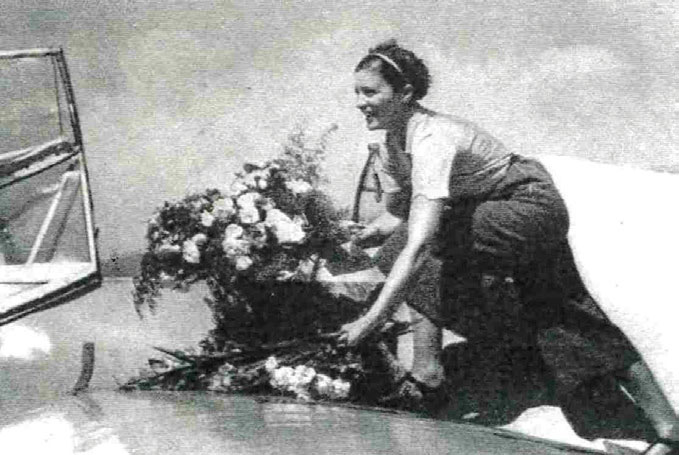 Let me come to the point after this inconsistency: I was flying over the skies of the United Kingdom in June. In those days, I did not have an airplane of my own, therefore I genuinely cared for this four-person Messerschmitt Me 108 manufactured by BFW-Bavarian Aircraft Factories, accomplishing its maiden flight in 1934. I heard of the existence of this beautiful discovery upon my return from my U.S. flight and I was looking forward to have the opportunity to see and examine it closely. After my flight to the United Kingdom, I decided that it would be a pity to miss the chance to conduct a groundbreaking activity with this airplane since it looked as if it had been designed for such achievements.
Let me come to the point after this inconsistency: I was flying over the skies of the United Kingdom in June. In those days, I did not have an airplane of my own, therefore I genuinely cared for this four-person Messerschmitt Me 108 manufactured by BFW-Bavarian Aircraft Factories, accomplishing its maiden flight in 1934. I heard of the existence of this beautiful discovery upon my return from my U.S. flight and I was looking forward to have the opportunity to see and examine it closely. After my flight to the United Kingdom, I decided that it would be a pity to miss the chance to conduct a groundbreaking activity with this airplane since it looked as if it had been designed for such achievements. 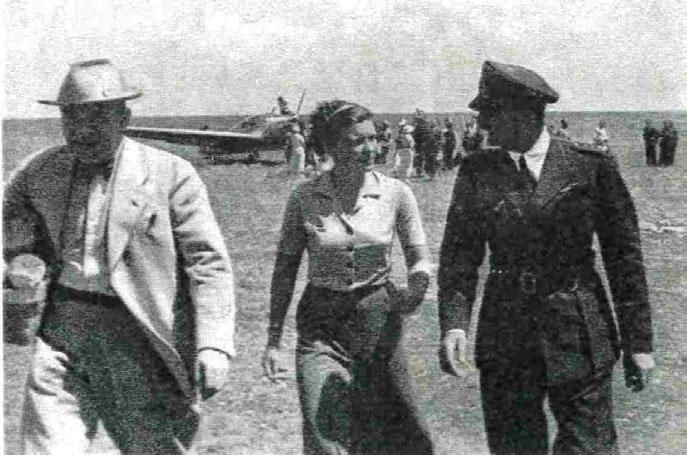 Me 108`s most critical feature is that as the fastest airplane in its category with a speed of 300km/hour, it has an aerodynamic design as well as a higher fuel capacity. It reminds me of a flying limousine with an interior design and a cabin with four leather covered seats where the passengers would feel as if they were executives. I was particularly affected by its elegant look in the air with its retractable landing gear. The maximum speed could be achieved on account of this feature.
Me 108`s most critical feature is that as the fastest airplane in its category with a speed of 300km/hour, it has an aerodynamic design as well as a higher fuel capacity. It reminds me of a flying limousine with an interior design and a cabin with four leather covered seats where the passengers would feel as if they were executives. I was particularly affected by its elegant look in the air with its retractable landing gear. The maximum speed could be achieved on account of this feature. 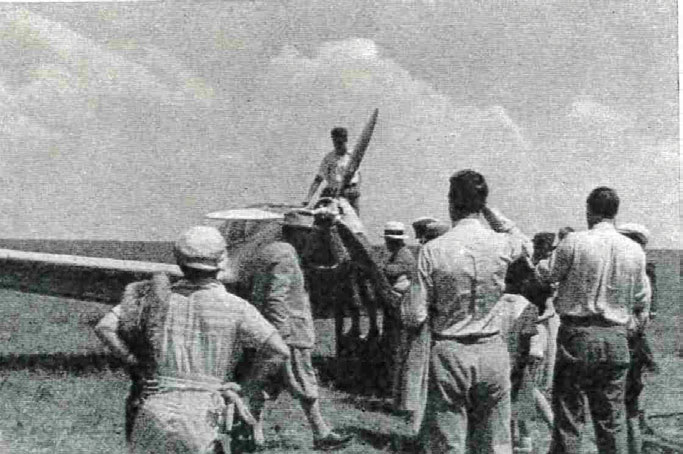 In light of my experiences so far, the eight-cylinder HM 8 Hirth engine of 250 horsepower displayed a quite robust performance at a high efficiency rate. Upon my return to Germany, I met with the BFW and Hirth Motoren GmbH companies and asked them to equip the airplane with high-capacity fuel tanks so that I could manage the airplane according to the flight I had planned to conduct soon. Then, working over the map, I started to think of a safe route that I could fly over in a single day. Since the airplane would not be ready before the first ten days of August, unfortunately the longest daytimes would be left behind. Finally, I decided to depart from Gleiwitz and draw a circle over the Asian coast of the Bosphorus and land in Istanbul. Then I would refuel the airplane and take off, heading towards Berlin Gleiwitz was located at the most reasonable position in Germany in the direction towards Asia. Moreover, I preferred Gleiwitz in order to gain two hours during the flight to Istanbul; in that way I might gain more time even under possible unfavorable weather conditions. BFW, Hirth and Shell companies helped me incredibly throughout the preliminary stages. I am utterly grateful for their efforts to render this activity successful.
In light of my experiences so far, the eight-cylinder HM 8 Hirth engine of 250 horsepower displayed a quite robust performance at a high efficiency rate. Upon my return to Germany, I met with the BFW and Hirth Motoren GmbH companies and asked them to equip the airplane with high-capacity fuel tanks so that I could manage the airplane according to the flight I had planned to conduct soon. Then, working over the map, I started to think of a safe route that I could fly over in a single day. Since the airplane would not be ready before the first ten days of August, unfortunately the longest daytimes would be left behind. Finally, I decided to depart from Gleiwitz and draw a circle over the Asian coast of the Bosphorus and land in Istanbul. Then I would refuel the airplane and take off, heading towards Berlin Gleiwitz was located at the most reasonable position in Germany in the direction towards Asia. Moreover, I preferred Gleiwitz in order to gain two hours during the flight to Istanbul; in that way I might gain more time even under possible unfavorable weather conditions. BFW, Hirth and Shell companies helped me incredibly throughout the preliminary stages. I am utterly grateful for their efforts to render this activity successful. 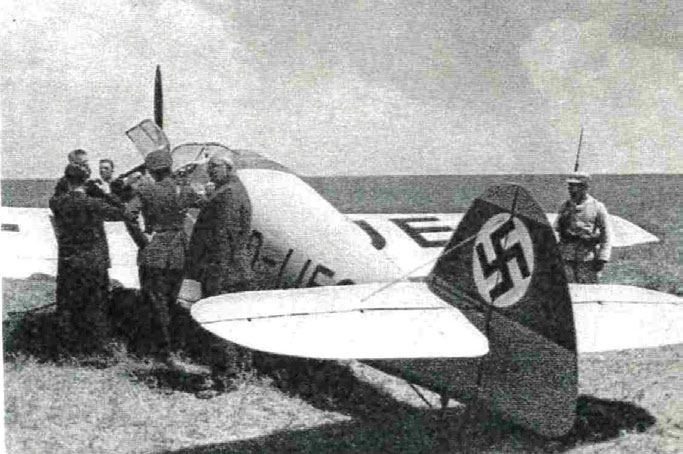 I arrived at Gleiwitz on August 12. The customs transactions and similar red tape had already been completed during the day for the flight to be launched at night. The engine was once again checked by the team of Hirth Company, the representatives of BFW examined the hull, wings and flight yokes while the Shell staff carried the colossal fuel cans one after another to fill the fuel tank. The airplane was available for departure at 6:00 p.m. I gently caressed the nose of the airplane and went to the hotel for rest. I woke up quite vigorously after sleeping until 1:00 a.m. At 2:00 a.m. It was pitch dark since the moon retired, yet many members of the press remained at the airport. I thought that the journalists criticized me for having selected a strange departure time, but I did not have another choice.
I arrived at Gleiwitz on August 12. The customs transactions and similar red tape had already been completed during the day for the flight to be launched at night. The engine was once again checked by the team of Hirth Company, the representatives of BFW examined the hull, wings and flight yokes while the Shell staff carried the colossal fuel cans one after another to fill the fuel tank. The airplane was available for departure at 6:00 p.m. I gently caressed the nose of the airplane and went to the hotel for rest. I woke up quite vigorously after sleeping until 1:00 a.m. At 2:00 a.m. It was pitch dark since the moon retired, yet many members of the press remained at the airport. I thought that the journalists criticized me for having selected a strange departure time, but I did not have another choice. 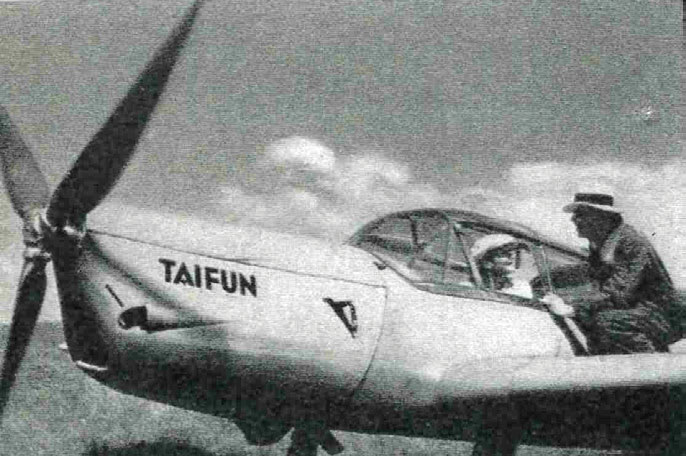 I was accidentally locked inside the airport building during the final check of the engine and nobody heard me screaming due to the noise of the engine running outside, 100 meters away. When I was about to lose all hope, I managed to get out of the building by jumping out from the window. Ten minutes later, I was in the air. The departure took place at the beginning of the dawn at 03:40 a.m. This was not my first full-fledged flight but flying from a runway with a short take-off distance of 180 meters was unfamiliar for me. In the beginning of the flight, first I drew my knees to my chest and sat, then I stretched and lay a bit and placed the air bag that I brought with me between my legs. I switched the lights occasionally to check the display panel. Shortly after the take-off, I entered to a foggy area that covered the space between the foot of the Tatra Mountains and the Pustza River in Hungary. The fog over the ground started to disappear upon the break of the day. I tried to figure out my location by observing the nearest settlements. Since ‘’Typhoon`` was not equipped with a radio, I had to identify my location by using the compass and the map. The train station at the tiny visible Hungarian town was quite camouflaged and the caption over it could hardly be read. Right at that moment, I thought of benefiting from a technical feature of Me 108. Everyone knows that someone inside a plane flying at a speed of over 250km/h cannot observe what is around quite well. So, I opened the flaps for a short while and decreased the speed to 100km/h, I examined the ground, identified my location and noticed that I was at the correct direction over Hajdúnánás. Then I closed the flaps and reached the normal cruising speed.
I was accidentally locked inside the airport building during the final check of the engine and nobody heard me screaming due to the noise of the engine running outside, 100 meters away. When I was about to lose all hope, I managed to get out of the building by jumping out from the window. Ten minutes later, I was in the air. The departure took place at the beginning of the dawn at 03:40 a.m. This was not my first full-fledged flight but flying from a runway with a short take-off distance of 180 meters was unfamiliar for me. In the beginning of the flight, first I drew my knees to my chest and sat, then I stretched and lay a bit and placed the air bag that I brought with me between my legs. I switched the lights occasionally to check the display panel. Shortly after the take-off, I entered to a foggy area that covered the space between the foot of the Tatra Mountains and the Pustza River in Hungary. The fog over the ground started to disappear upon the break of the day. I tried to figure out my location by observing the nearest settlements. Since ‘’Typhoon`` was not equipped with a radio, I had to identify my location by using the compass and the map. The train station at the tiny visible Hungarian town was quite camouflaged and the caption over it could hardly be read. Right at that moment, I thought of benefiting from a technical feature of Me 108. Everyone knows that someone inside a plane flying at a speed of over 250km/h cannot observe what is around quite well. So, I opened the flaps for a short while and decreased the speed to 100km/h, I examined the ground, identified my location and noticed that I was at the correct direction over Hajdúnánás. Then I closed the flaps and reached the normal cruising speed. 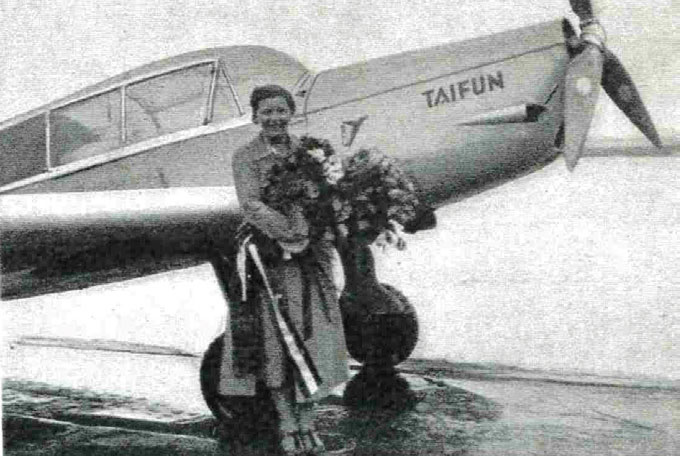 The engine was running at the front like a noisy sewing machine. I had no thoughts about my fatigue since I was busy observing the surroundings and discovering a brand-new geography. I coincided with a rain cloud that I did not take seriously; however, it worried me slightly for my return. With the help of the high-speed engine, I was quickly passing all the zones over the map and since the take-off at 6:00 a.m., I already reached the fifth country. After the high mountains of Romania, I flew over a valley towards the Bulgarian border. The weather cleared up and I was surrounded by cloudless blue skies. At the horizon I was able to see the Sea of Marmara that I flew over during my two previous flights. At that very instant, I realized how hard it was to sit in the cabin for so long. Frustrated, I was trying to get comfortable by placing the air bag from one side to the other. I was about to close my eyes from fatigue, but it stopped when I started to descend. I had a slice of bread and a few grapes during the flight. I did not drink anything as I was not thirsty. When approached from Europe, the airport at Yesilkoy was situated at the back of a forbidden zone in front of Istanbul. We agreed with Mr. Hennig for the deployment of a person at the Asian part of the Bosphours for the confirmation of my flight’s passage over the Asian continent. Therefore, Mr. Hennig arranged the deployment of a Turkish officer at the Haydar Pasha Station at the South of Üsküdar district. I flew over the Asian continent at 9:20, 5 hours and 40 minutes after the take-off and that Turkish officer had been the first person to notify Germany of my passage to Asia.
The engine was running at the front like a noisy sewing machine. I had no thoughts about my fatigue since I was busy observing the surroundings and discovering a brand-new geography. I coincided with a rain cloud that I did not take seriously; however, it worried me slightly for my return. With the help of the high-speed engine, I was quickly passing all the zones over the map and since the take-off at 6:00 a.m., I already reached the fifth country. After the high mountains of Romania, I flew over a valley towards the Bulgarian border. The weather cleared up and I was surrounded by cloudless blue skies. At the horizon I was able to see the Sea of Marmara that I flew over during my two previous flights. At that very instant, I realized how hard it was to sit in the cabin for so long. Frustrated, I was trying to get comfortable by placing the air bag from one side to the other. I was about to close my eyes from fatigue, but it stopped when I started to descend. I had a slice of bread and a few grapes during the flight. I did not drink anything as I was not thirsty. When approached from Europe, the airport at Yesilkoy was situated at the back of a forbidden zone in front of Istanbul. We agreed with Mr. Hennig for the deployment of a person at the Asian part of the Bosphours for the confirmation of my flight’s passage over the Asian continent. Therefore, Mr. Hennig arranged the deployment of a Turkish officer at the Haydar Pasha Station at the South of Üsküdar district. I flew over the Asian continent at 9:20, 5 hours and 40 minutes after the take-off and that Turkish officer had been the first person to notify Germany of my passage to Asia. 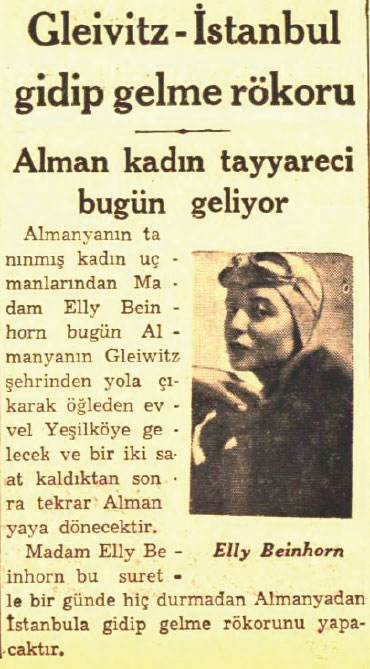 From Germany to Asia in 5 hours and 40 minutes with a tiny sport airplane! I realized the meaning of this when I compared it with my first flight experiences in 1928. I landed at Yesilkoy at 9:34 and was welcomed by an enthusiastic crowd waiting for me with flowers, chocolate, soap bars, towels, delicious food and even with a bathing suit so that I could swim and cool off in the Sea of Marmara. I have to mention that Dear Mr. Hennig got too excited and he fell to the ground. The welcoming ceremony at the airport was perfectly organized and I was really touched by it. In order to celebrate my landing, the German Colony5 composed of German Chief Consul, Deputy Ambassador (chargée d`affaires) of Germany, Director General of Deutsche Bank in Turkey Mr. Weidmann and Director General of Selaheddin Ali Pasha’s company Mr. Hitzigrath6 were at the airport. I can say that all Turkish people involved in the project were there. I heard so many names in the first 5 minutes that I cannot even pronounce, I was able to keep only a few in mind. The executives from the military, representatives of various sports clubs in Turkey, the first Turkish female pilot, Secretary General of the Olympics Committee and the members of all national and international press were gathered there. Everyone around me was full of joy and I could observe the happiness I created in the Turkish people because of my selection of their country for this flight. By the way, I must also mention that I clearly did not find it quite sympathetic of some Turkish people that were asking me to sell and leave my airplane there.
From Germany to Asia in 5 hours and 40 minutes with a tiny sport airplane! I realized the meaning of this when I compared it with my first flight experiences in 1928. I landed at Yesilkoy at 9:34 and was welcomed by an enthusiastic crowd waiting for me with flowers, chocolate, soap bars, towels, delicious food and even with a bathing suit so that I could swim and cool off in the Sea of Marmara. I have to mention that Dear Mr. Hennig got too excited and he fell to the ground. The welcoming ceremony at the airport was perfectly organized and I was really touched by it. In order to celebrate my landing, the German Colony5 composed of German Chief Consul, Deputy Ambassador (chargée d`affaires) of Germany, Director General of Deutsche Bank in Turkey Mr. Weidmann and Director General of Selaheddin Ali Pasha’s company Mr. Hitzigrath6 were at the airport. I can say that all Turkish people involved in the project were there. I heard so many names in the first 5 minutes that I cannot even pronounce, I was able to keep only a few in mind. The executives from the military, representatives of various sports clubs in Turkey, the first Turkish female pilot, Secretary General of the Olympics Committee and the members of all national and international press were gathered there. Everyone around me was full of joy and I could observe the happiness I created in the Turkish people because of my selection of their country for this flight. By the way, I must also mention that I clearly did not find it quite sympathetic of some Turkish people that were asking me to sell and leave my airplane there. 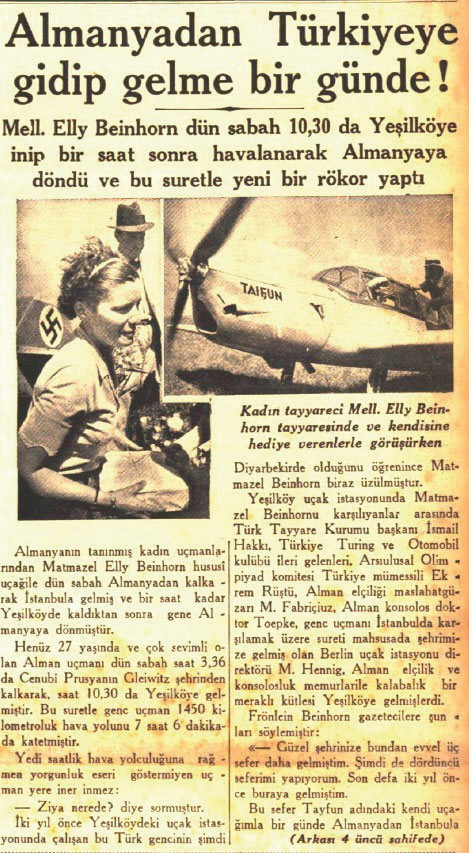 I was invited to a hotel nearby for breakfast. However, taking the return path that would possibly be challenging into consideration, I decided to avoid losing time and had the breakfast inside the airplane. One of the most interesting moments I had there was the moment I was asked if I would like to wash my hands.7 “Sure”, I replied and I was directed to a small door, I had difficulty in walking among a group of nearly 100 people. I was quite surprised to see a bathroom that I could never imagine. As I tried to leave the bathroom, the crowd outside happened to block the door so once again I had difficulty to get out. Then accompanied by the same group, I entered another bathroom which I was accustomed to. Yes, the aforementioned had been my experiences at the end of a long flight. I returned to my serious state again. I started the engine at 10:47 after a break of nearly an hour and shook Mr. Hennig’s hand and said goodbye to him. He was the person who made sure everything was flawless during my 1-hour break in Istanbul. Hennig had a few more days to rest at the Sea of Marmara until the next scheduled flight to Germany while I was aware that I was about to endure the hardest part of my flight as the return path was 450 km longer than the arrival. Besides, I was not fresh as I had to wake up at 1:00 a.m. in the morning and I realized my eyes were once again about to close down shortly after my departure from Istanbul. The weather was spectacular; the ground below was flat and therefore I was able to relax a bit. My flight back over the Transylvanian Alps had been easier than my arrival. The rain clouds ceased to exist, and I was effortlessly advancing at an altitude of 3,000 meters. I had some fruit and cakes and drank all the coffee in the flask. For those who do not fly, I have to mention that one can take care of other tasks inside a modern passenger aircraft. The flight in the free space above is quite different than car travel on the ground, therefore drivers have to be attentive towards all types of unexpected obstacles throughout driving. I, on the other hand, read during my return half of the magazine that Mr. Brindlinger from BFW Company gave me as I started the engine. On my return, dark clouds appeared at the Tatra region which I passed effortlessly during my arrival, so I had to fly blind by merely checking the control panel for a certain while. I must confess that I was pleased to have attended a course for flying blind shortly before so that I could be able to fly under such conditions. Because, in the old days, I had panicked a bit when passing clouds in tiny sport airplanes while flying without a radio connection. At last, I arrived back in the land of Germany; I flew over Gleiwitz and a message was transmitted to Berlin from the airport there. I had 200 liters fuel remaining at that moment and I would be able to fly 1,000 km more. Before I reached Berlin, I was filled with the joy of arriving at home, the weather went bad and it started to rain. The clouds covered all places from the ground up to my nose; I was about to crash into the radio tower at Königswusterhausen. Beyond all my projections, it rained quite heavily. I thought that this could restrain the press members and photographers; then I realized I was wrong. At 18:08, “Typhoon” landed at the Tempelhof Airport where I was welcomed by countless people. Most of the people there learned about my project later as I managed to cover my project of flying to Asia from Germany and turning back in one day as much as possible.I was happy to see the representatives of the Ministry of Aviation, Tempelhof Airport, German Aviation Industry Association and various industrial enterprises along with my friends Udet8 and von Gronau9 and airwomen Hertha von Gronau10 and Luise Hoffmann11 there. Everyone was busy asking me what I brought with me from Turkey. That question reminded me of the pain the thorns on the ground of Istanbul Airport had caused on the soles of my feet. I drew away from the people welcoming me for a while and went to the hangar where the Me 108 was located. The airplane stood there as if nothing had happened to her. I looked at the engine and thought once again: it is great to be among the people to benefit from the development of our technology and industry!
I was invited to a hotel nearby for breakfast. However, taking the return path that would possibly be challenging into consideration, I decided to avoid losing time and had the breakfast inside the airplane. One of the most interesting moments I had there was the moment I was asked if I would like to wash my hands.7 “Sure”, I replied and I was directed to a small door, I had difficulty in walking among a group of nearly 100 people. I was quite surprised to see a bathroom that I could never imagine. As I tried to leave the bathroom, the crowd outside happened to block the door so once again I had difficulty to get out. Then accompanied by the same group, I entered another bathroom which I was accustomed to. Yes, the aforementioned had been my experiences at the end of a long flight. I returned to my serious state again. I started the engine at 10:47 after a break of nearly an hour and shook Mr. Hennig’s hand and said goodbye to him. He was the person who made sure everything was flawless during my 1-hour break in Istanbul. Hennig had a few more days to rest at the Sea of Marmara until the next scheduled flight to Germany while I was aware that I was about to endure the hardest part of my flight as the return path was 450 km longer than the arrival. Besides, I was not fresh as I had to wake up at 1:00 a.m. in the morning and I realized my eyes were once again about to close down shortly after my departure from Istanbul. The weather was spectacular; the ground below was flat and therefore I was able to relax a bit. My flight back over the Transylvanian Alps had been easier than my arrival. The rain clouds ceased to exist, and I was effortlessly advancing at an altitude of 3,000 meters. I had some fruit and cakes and drank all the coffee in the flask. For those who do not fly, I have to mention that one can take care of other tasks inside a modern passenger aircraft. The flight in the free space above is quite different than car travel on the ground, therefore drivers have to be attentive towards all types of unexpected obstacles throughout driving. I, on the other hand, read during my return half of the magazine that Mr. Brindlinger from BFW Company gave me as I started the engine. On my return, dark clouds appeared at the Tatra region which I passed effortlessly during my arrival, so I had to fly blind by merely checking the control panel for a certain while. I must confess that I was pleased to have attended a course for flying blind shortly before so that I could be able to fly under such conditions. Because, in the old days, I had panicked a bit when passing clouds in tiny sport airplanes while flying without a radio connection. At last, I arrived back in the land of Germany; I flew over Gleiwitz and a message was transmitted to Berlin from the airport there. I had 200 liters fuel remaining at that moment and I would be able to fly 1,000 km more. Before I reached Berlin, I was filled with the joy of arriving at home, the weather went bad and it started to rain. The clouds covered all places from the ground up to my nose; I was about to crash into the radio tower at Königswusterhausen. Beyond all my projections, it rained quite heavily. I thought that this could restrain the press members and photographers; then I realized I was wrong. At 18:08, “Typhoon” landed at the Tempelhof Airport where I was welcomed by countless people. Most of the people there learned about my project later as I managed to cover my project of flying to Asia from Germany and turning back in one day as much as possible.I was happy to see the representatives of the Ministry of Aviation, Tempelhof Airport, German Aviation Industry Association and various industrial enterprises along with my friends Udet8 and von Gronau9 and airwomen Hertha von Gronau10 and Luise Hoffmann11 there. Everyone was busy asking me what I brought with me from Turkey. That question reminded me of the pain the thorns on the ground of Istanbul Airport had caused on the soles of my feet. I drew away from the people welcoming me for a while and went to the hangar where the Me 108 was located. The airplane stood there as if nothing had happened to her. I looked at the engine and thought once again: it is great to be among the people to benefit from the development of our technology and industry!  August 17, 1935 - Elly Beinhorn Reflections in the Turkish Press Beinhorn arrived in Istanbul through this groundbreaking flight to Istanbul in 1935, however it was not her first visit to Turkey. By detecting the Turkish Press, the first news on Elly Beinhorn can be recognized in an article dated December 7, 1931 informing that she would be flying over Turkish skies during her world tour back on that date. According to the news, Beinhorn would be taking off from Germany, flying over Turkey, Iraq, Iran, Pakistan and Singapore in Asian geography and then heading towards Australia. Beinhorn relayed in her memoirs that the flight permit was granted on December 3, 1931 and that she launched the flight on December 4, 1931 around 9:00 in the morning. She reached Sofia in seven hours and landed in Istanbul in the afternoon on December 5. According to what she wrote in her memoirs, Beinhorn stayed for a day in Istanbul and was fascinated by the city. She mentioned that the city’s being located on two different continents added to its unique beauty. The next day, Beinhorn reached the skies of Konya but due to the cold weather and snow, she had to make a forced landing and stayed and waited there for two days.12 Beinhorn stated that Jim Mollison, who accomplished another record breaking flight, experienced a similar incident and added that Mollison had to make an unauthorized forced landing in Konya, and that the Turkish authorities reacted and then entertained him at a hotel for five days and sent him abroad on a train. In respect with the record-breaking flight, Turkish newspaper Cumhuriyet announced on August 13, 1935 that Beinhorn launched her flight towards Turkey (Photo 6) and in the Ulus newspaper dated August 14, 1935 Beinhorn was mentioned briefly with the date of August 13. The headline of the Cumhuriyet newspaper on August 14 ``from Germany to Turkey and back in a single day!” detailed information on Beinhorn’s landing at Yesilkoy Airport and the welcoming ceremony held there. A difference between the durations of the flight in the Turkish press and in the text written in German by Beinhorn could be observed. While Beinhorn indicates her flight from Gleiwitz to Istanbul lasted 5 hours and 40 minutes in her brochures and memoirs, she expressed the duration of the flight as 7 hours and 6 minutes in her personal statement to a Turkish newspaper. There is a possibility that the cause of difference had been the time-difference between the two countries.
August 17, 1935 - Elly Beinhorn Reflections in the Turkish Press Beinhorn arrived in Istanbul through this groundbreaking flight to Istanbul in 1935, however it was not her first visit to Turkey. By detecting the Turkish Press, the first news on Elly Beinhorn can be recognized in an article dated December 7, 1931 informing that she would be flying over Turkish skies during her world tour back on that date. According to the news, Beinhorn would be taking off from Germany, flying over Turkey, Iraq, Iran, Pakistan and Singapore in Asian geography and then heading towards Australia. Beinhorn relayed in her memoirs that the flight permit was granted on December 3, 1931 and that she launched the flight on December 4, 1931 around 9:00 in the morning. She reached Sofia in seven hours and landed in Istanbul in the afternoon on December 5. According to what she wrote in her memoirs, Beinhorn stayed for a day in Istanbul and was fascinated by the city. She mentioned that the city’s being located on two different continents added to its unique beauty. The next day, Beinhorn reached the skies of Konya but due to the cold weather and snow, she had to make a forced landing and stayed and waited there for two days.12 Beinhorn stated that Jim Mollison, who accomplished another record breaking flight, experienced a similar incident and added that Mollison had to make an unauthorized forced landing in Konya, and that the Turkish authorities reacted and then entertained him at a hotel for five days and sent him abroad on a train. In respect with the record-breaking flight, Turkish newspaper Cumhuriyet announced on August 13, 1935 that Beinhorn launched her flight towards Turkey (Photo 6) and in the Ulus newspaper dated August 14, 1935 Beinhorn was mentioned briefly with the date of August 13. The headline of the Cumhuriyet newspaper on August 14 ``from Germany to Turkey and back in a single day!” detailed information on Beinhorn’s landing at Yesilkoy Airport and the welcoming ceremony held there. A difference between the durations of the flight in the Turkish press and in the text written in German by Beinhorn could be observed. While Beinhorn indicates her flight from Gleiwitz to Istanbul lasted 5 hours and 40 minutes in her brochures and memoirs, she expressed the duration of the flight as 7 hours and 6 minutes in her personal statement to a Turkish newspaper. There is a possibility that the cause of difference had been the time-difference between the two countries.  Differences could be spotted in the names and titles of the people in the welcoming committee given in the Cumhuriyet newspaper and the names stated by Beinhorn. According to the information provided by Beinhorn, Turkey’s first female pilot had also been at the airport to welcome her, yet no such information appeared in Turkish press. Mr. Ismail Hakki – President of the Turkish Aircraft Society, representatives from the Turkey Turing and Automobile Association, Turkish Representative of the International Olympics Committee Mr. Ekrem Rustu, Germany’s Deputy Ambassador (chargée d`affaires) to Ankara Mr. Fabricius, Chief Consul to Istanbul Dr. Toepke and Director of the Berlin Airport Ground Services Mr. Hennig are among the people indicated. In the same interview, Beinhorn landing in Yesilkoy at 10:30 spoke of the weather conditions and her experiences during the flight and took off to Berlin at 11:15 after the welcoming ceremony and her brief break for rest. She signaled that the air mail services between Turkey and Germany would possibly be launched in her statement with the following words: ``This time, I intended to beat the record of flying to Istanbul from Germany and back in a single day with my own airplane named Typhoon. If I achieve this, Daily air mail services will be launched between Berlin and Istanbul.`` The most interesting part of the news is without doubt her question “Where is Ziya?” as soon as she got off the plane, wishing to see the young guy named working at the Yeşilköy Airport she met previously in Turkey. The press states that Beinhorn was disappointed to learn that Ziya lived in Diyarbakır then. This personal detail attracts attention as one of the most beautiful examples of the friendship between Turks and Germans at the time. Typhoon’s reflections over Asia Taking a look at the content of news appearing in Turkish press, the record breaking flight attempt that took place on August 13, 1935 was successfully completed and created great reactions in the country. These types of record beating attempts realized during times when aviation recently started to develop in Europe and across the world should be qualified as demonstrators of prominent prestige both for pilots and for the targeted countries. Moreover, since today’s technical infrastructures such as modern navigation, autopilot and radars did not exist 85 years ago, the value of covering a distance of 3,570 km within 13.5 hours in terms of technical facilities should be appreciated. German female pilot Elly Beinhorn selected Turkey, where she had been a guest during her previous record beating attempts, for a different groundbreaking flight with the newly manufactured Me 108 and made her mark on a critical project to launch daily air mail services between the countries, as she also mentioned in her interview. In her memoirs, Beinhorn concluded the chapter she wrote on this record beating flight with the following words:13 “This flight created great reflections across the world. ‘Me 108’, which was not known by anyone except Germany until August 12, started to be referred as ‘Messerschmitt Typhoon’ in the aviation literature in many regions in the world.”
Differences could be spotted in the names and titles of the people in the welcoming committee given in the Cumhuriyet newspaper and the names stated by Beinhorn. According to the information provided by Beinhorn, Turkey’s first female pilot had also been at the airport to welcome her, yet no such information appeared in Turkish press. Mr. Ismail Hakki – President of the Turkish Aircraft Society, representatives from the Turkey Turing and Automobile Association, Turkish Representative of the International Olympics Committee Mr. Ekrem Rustu, Germany’s Deputy Ambassador (chargée d`affaires) to Ankara Mr. Fabricius, Chief Consul to Istanbul Dr. Toepke and Director of the Berlin Airport Ground Services Mr. Hennig are among the people indicated. In the same interview, Beinhorn landing in Yesilkoy at 10:30 spoke of the weather conditions and her experiences during the flight and took off to Berlin at 11:15 after the welcoming ceremony and her brief break for rest. She signaled that the air mail services between Turkey and Germany would possibly be launched in her statement with the following words: ``This time, I intended to beat the record of flying to Istanbul from Germany and back in a single day with my own airplane named Typhoon. If I achieve this, Daily air mail services will be launched between Berlin and Istanbul.`` The most interesting part of the news is without doubt her question “Where is Ziya?” as soon as she got off the plane, wishing to see the young guy named working at the Yeşilköy Airport she met previously in Turkey. The press states that Beinhorn was disappointed to learn that Ziya lived in Diyarbakır then. This personal detail attracts attention as one of the most beautiful examples of the friendship between Turks and Germans at the time. Typhoon’s reflections over Asia Taking a look at the content of news appearing in Turkish press, the record breaking flight attempt that took place on August 13, 1935 was successfully completed and created great reactions in the country. These types of record beating attempts realized during times when aviation recently started to develop in Europe and across the world should be qualified as demonstrators of prominent prestige both for pilots and for the targeted countries. Moreover, since today’s technical infrastructures such as modern navigation, autopilot and radars did not exist 85 years ago, the value of covering a distance of 3,570 km within 13.5 hours in terms of technical facilities should be appreciated. German female pilot Elly Beinhorn selected Turkey, where she had been a guest during her previous record beating attempts, for a different groundbreaking flight with the newly manufactured Me 108 and made her mark on a critical project to launch daily air mail services between the countries, as she also mentioned in her interview. In her memoirs, Beinhorn concluded the chapter she wrote on this record beating flight with the following words:13 “This flight created great reflections across the world. ‘Me 108’, which was not known by anyone except Germany until August 12, started to be referred as ‘Messerschmitt Typhoon’ in the aviation literature in many regions in the world.”  On the 75th anniversary of this groundbreaking flight, postage stamps were printed in Germany with Beinhorn’s name and circulated on August 12, 2010.14 Making her mark by herself on many historical flights, Beinhorn published 13 books throughout her career to relay her experiences, and ended her career as a pilot in 1979 and in 2007 she passed away in Munich at the age of 100. Hosted many times by the Turkish skies, Elly Beinhorn is recognized as a historical personality and an exemplary character for female pilots across the world
On the 75th anniversary of this groundbreaking flight, postage stamps were printed in Germany with Beinhorn’s name and circulated on August 12, 2010.14 Making her mark by herself on many historical flights, Beinhorn published 13 books throughout her career to relay her experiences, and ended her career as a pilot in 1979 and in 2007 she passed away in Munich at the age of 100. Hosted many times by the Turkish skies, Elly Beinhorn is recognized as a historical personality and an exemplary character for female pilots across the world